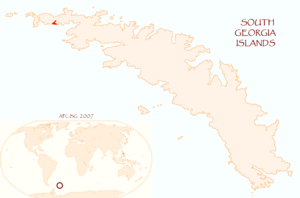Schlieper Bay facts for kids
Schlieper Bay is a beautiful bay located on the south coast of South Georgia. A bay is a part of the sea that curves into the land. Schlieper Bay is about 1 mile (1.6 kilometers) wide. It is found between two points of land called Romerof Head and Weddell Point.
The bay was named sometime between 1905 and 1912. It was named after the director of a fishing company called the Compañía Argentina de Pesca.
Contents
Exploring Schlieper Bay
Early Visits by Scientists
In 1911, British scientists came to Schlieper Bay. They were on a ship called the Undine. Their job was to explore and map the coast of South Georgia. These early visits helped people learn more about this remote island.
Home to Many Seals
Schlieper Bay is a very important place for wildlife. It is especially known for its large population of seals. Scientists have found that around 20,000 seals make their homes and raise their young in Schlieper Bay. This makes it a busy and lively area for these amazing marine animals.
Protecting Local Birds
Saving the South Georgia Pipit
For a long time, rats were a big problem on South Georgia. These rats were accidentally brought to the island by people, like whalers. The rats would steal and eat the eggs of local birds. This put many bird populations in danger.
However, a big effort was made to remove the rats from the island. After these efforts, scientists found something wonderful in Schlieper Bay. They discovered a nest of South Georgia pipits with five healthy chicks! The South Georgia pipit is a special bird. It is the world's most southerly songbird. Finding these chicks showed that the island's birds were starting to recover.
Schlieper Bay During Conflict
Remaining Under British Control
In 1982, there was a conflict known as the Falklands War. During this time, some British people in a place called Grytviken on South Georgia had to leave. However, about 15 other Britons stayed in parts of the island that were not reached by the opposing forces.
Because of events in Grytviken, the opposing forces could not take over the whole island. This meant that areas like Schlieper Bay stayed under British control. Other places that remained under British control included Bird Island base and field camps at Lyell Glacier and St. Andrews Bay.


